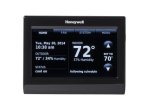Sharing this great article by Dan DiClerico from Consumer Reports. You can click on the link to see the original post. Hitting the hottest part of summer in Texas sharing money saving tips on those electrical bills is essential! What do you do to stay cool and save money during the heat of summer?


By Dan DiClerico55 minutes ago
5-ways-thermostat-save-money
Thermostats control nearly 10 percent of the nation’s energy use. In your home, it's probably closer to 50 percent, since heating and cooling account for roughly half of the energy consumption of the average residence. Programmable thermostats are supposed to save energy by automatically controlling temperatures. That wasn’t the case with the early-generation models, which is why the product was dropped from the Energy Star program in 2009. But many programmable thermostats from Consumer Reports' latest tests combine superb ease-of-use with impressive energy-management features. Here are five innovations to consider if you’re in the market.
Proximity sensing. Also called geofencing, this feature allows a thermostat to track your location, typically through a smart phone app, and automatically adjust the temperature. For example, theAllure Energy EverSense thermostat will turn your air conditioner on or off in the summer once you (and your app-equipped smart phone) reach a set distance from your home. Honeywell’s Lyric thermostat uses a similar technology, plus its Smart Cues provide maintenance reminders, extreme weather alerts, and other helpful information.
Home energy display. If you’re like most Americans, you learn about your home’s energy consumption at the end of the month when the utility bill comes in the mail. Thermostats with a home energy display give you that usage information in real time, including visual prompts for when your home is running efficiently or inefficiently. That’s a better motivator to conserve. The Home IQ web portal that comes free with the ecobee EB-SMARTS1-01 also provides estimated energy savings in real dollars. Two more models to consider are the American Standard AccuLink AZone950 and the Trane ComfortLink II Smart Control TZone950.
Auto scheduling. The Nest Learning Thermostat is the best example of this innovation, which enables the thermostat to program your temperature preferences based on settings you make during the first week. Auto-scheduling can take the guesswork out of climate control, though we found the Nest somewhat hard to operate during that initial period of interaction.
Price response. Thermostats with this feature will automatically adjust your home systems during peak demand periods, when the price of electricity may be high. For example, on very hot days when demand spikes, the thermostat will turn your central AC up a degree or two. That could be a huge energy and money saver, though most homes in the U.S. still don’t receive time-of-use pricing from their utility company. If your home has a smart meter, ask your utility company if it also offers time-of-use rates, as well as recommendations for a programmable thermostat with price-response capability.
Voice recognition. Usability is key to energy savings, and what could be easier than adjusting your thermostat from the comfort of your sofa. That’s the beauty of the Honeywell RTH959OWF, the industry’s first voice-activated programmable thermostat. It’s not quite Siri-like in its response. Instead, you choose from about a dozen pre-set commands, such as “make it cooler” or “I’m feeling cold.” This thermostat is also incredibly easy to program and connect to the Internet, making it our highest-rated thermostat.
—Daniel DiClerico (@dandiclerico on Twitter)













No comments:
Post a Comment